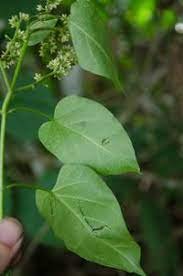NAME: Gongronema latifolium
COMMON NAMES: Utazi (English), Bush Buck (English)
LOCAL NAMES: Utazi (Igbo), Arokeke (Yoruba), Okazi (Ibibio)
MORPHOLOGICAL DESCRIPTION: Gongronema latifolium, commonly known as Utazi, is a leafy green plant characterized by its large, glossy, dark green leaves. The leaves are heart-shaped with serrated edges and have a slightly bitter taste and aromatic flavor. The plant can grow as a vine or shrub and can reach heights of about 5 meters when mature.
USEFUL PART(s): The leaves of Gongronema latifolium are the most commonly used part of the plant.
GENERAL USES:
Culinary: The leaves of Utazi are used in various culinary dishes in African cuisine, particularly in Nigeria. They are added to soups, stews, and sauces to impart a distinctive bitter taste and flavor to the dishes.
Medicinal: In traditional medicine, the leaves of Gongronema latifolium are believed to have various health benefits. They are used for their potential anti-inflammatory, anti-diabetic, and digestive properties, among others. However, these uses require further scientific research and validation.
GEOGRAPHIC DISTRIBUTION: Gongronema latifolium is native to West Africa and is commonly found in countries such as Nigeria, Ghana, and Cameroon.
WHY IS IT GREEN? Gongronema latifolium is considered "green" for several reasons, both in terms of its physical characteristics and its environmental contributions. Its green leaves are a symbol of its vitality and health benefits. Additionally, its cultivation and use align with sustainable practices.
ENVIRONMENTAL IMPACT:
Biodiversity Support: Utazi leaves can attract and support pollinators and other insects, contributing to local biodiversity.
Cultural Sustainability: The cultivation and use of Gongronema latifolium in local cuisines promote traditional and cultural practices, preserving indigenous knowledge and sustainable food systems.
FUN FACT: The name "Utazi" is derived from the Igbo language, and the plant is highly regarded for its bitter taste, which adds a unique flavor profile to various dishes.
FURTHER READING: To learn more about Gongronema latifolium, its culinary uses, traditional medicinal applications, and cultural significance, you can explore ethnobotanical studies, culinary resources, and traditional medicine literature related to West African plants.


